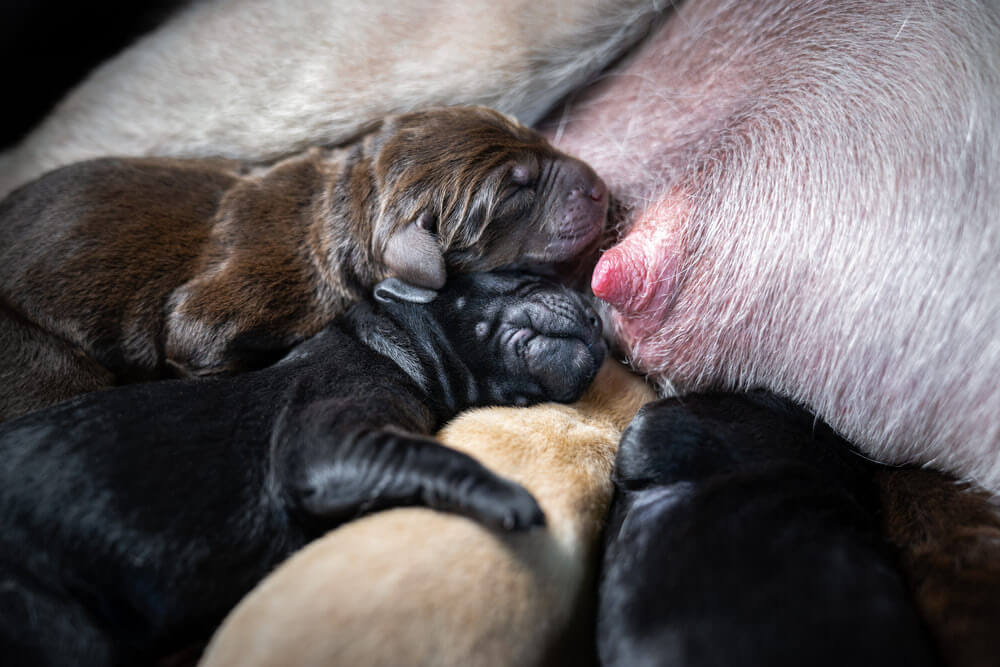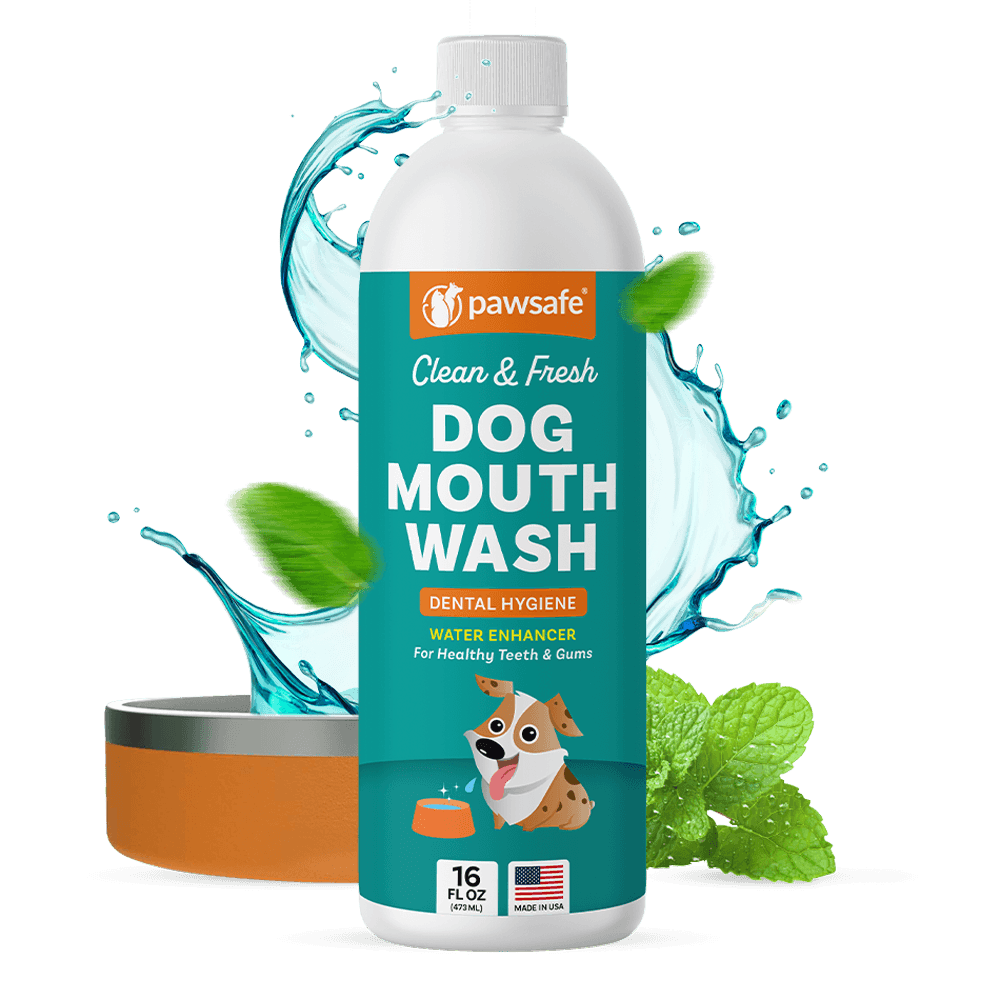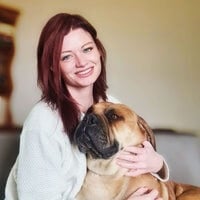
When a dog nibbles with just their front teeth, we call it dog cobbing, named for the action of nibbling a corn cob. Some may also know it as the adorable pibble nibble.
Dog cobbing is a simple action where they peel back their upper and lower lips and chomp their front teeth together in a gentle nibbling action. It’s usually very gentle and not the same as biting or gnawing. Of course, if your dog cobs on you, you want to make sure to add a canine mouthwash to their water for hygiene purposes. Understanding teeth chattering behaviors can help you distinguish between different oral behaviors.
All dogs will cob at an itch, but some gently nibble us, their blankets, toys, and even the cat. So why do dogs cob, and what does it mean? Let’s take a closer look by referring to work of Dr. Bonnie Beaver on Canine Behavior[1] and studies[2] on dog affection.
Table of Contents
So, Why Do Dogs Cob (Pibble Nibble)?
Dogs “cob” or nibble as a means to exhibit affection, seek attention, or interact with their owners. This behavior often mimics the way puppies play with their littermates and is usually not intended to harm. It can also be a self-soothing behavior for some dogs, helping them to feel relaxed and secure.
It is also called corn cobbing, pibble nibbles or just nibbling.
Cobbing is universal dog behavior. It happens for several reasons.
What Does Dog Cobbing Mean?
Cobbing” or “nibbling” is a behavior observed in many dogs. It occurs when a dog gently holds or nibbles a person’s hand or arm between their teeth. This behavior is often a form of affection or a way for dogs to seek attention and is typically not aggressive or harmful.
To Stimulate Milk
Newborn puppies will cob on their mother’s teat to encourage milk production. It’s a very early primal movement that starts as suckling. Because it is such a vital part of early development, it can become both a sign of affection and a way to self-soothe later in life.

To Gather Extra Sensory Information
Dogs have an extra organ for detecting pheromones in the roof of their mouth called the Jacobson’s organ. As newborn puppies, this helps them identify and find their mother when they are still blind and deaf.
As adults, dogs still use this organ to gather extra information they can’t get from their powerful noses. In fact, it’s one reason the dogs may like socks so much. By lifting their front lips and gently nibbling on you, a dog can get an extra whiff of the chemicals and pheromones in your skin or from another dog and gather extra information.
To Show Affection
The most common reason for corn cobbing in adult dogs is to show affection. Ultimately, nibbling behavior is a form of grooming or a dog’s way of giving a gentle scratch. When dogs show affection, they may start grooming by licking one another’s ears or nibbling on each other.
Mother dogs may even cob their puppies, so it is not uncommon to see a dog cobbing a baby. Of course, never leave your baby with a dog unsupervised, no matter how gentle and affectionate they are. Dogs may even cob cats if they have bonded sufficiently.

To Self Soothe
Dogs will often lick themselves to calm down, relax, and self-soothe. The action of licking releases feel-good chemicals in their brain that help them relieve stress. For anxious dogs or dogs in pain, licking can sometimes become excessive.
Since cobbing is a soothing activity associated with bonding, it also helps soothe a dog. So they may start to nibble on their blankets and toys when they want to relax or settle down to sleep. Like licking, they may start to do this excessively if they start relying on the action of cobbing to feel better when they are anxious.
If cobbing becomes chewing, and your dog doesn’t stick to their chew toys, you may need to invest in a spray to keep dogs from chewing to protect your furniture.

Fresh Breath The Easy Way
Just add to the water bowl to support cleaner mouths and noticeably fresher breath without daily brushing struggles.
Shop Now 👉Fresh Breath Guarantee • 90-Day PawSafe® Promise
To Get Your Attention
Another common reason that dogs nibble on you is to get your attention. If you are on the couch, scrolling on your phone, and you feel a gentle dog nibble on your arm, they may be politely asking for your attention. This is the same as when a dog bites your hand when they are excited or playing.
A dog should never be allowed to nip or bite, even when playing. But soft cobbing or gentle nibbling for your attention is not a problem behavior, and you can return the favor with a good ear scratch.
To Scratch An Itch
The most common reason for cobbing is when your dog has a sudden itch that they need to scratch. In this case, the chomping motion with the front teeth will be a little stronger as they try to scratch themselves.
There are plenty of areas on a dog’s body they can’t reach with their back paws, so they use their chompers to scratch instead.

Why Is My Dog Cobbing Me?

A dog will usually cob you to show love and affection. It is essentially a soothing, gentle way of grooming you, not unlike licking. They may also be gathering information about you through the pheromones on your skin that the organ on the roof their mouth can detect.
Cobbing is also something a dog may do to get your attention, much like nudging your arm.
What Does Cobbing Mean For Dogs?
Cobbing in dogs refers to a behavior where a dog gently holds or nibbles on a person’s hand or arm, often without applying enough pressure to cause harm. It’s a form of mouthing that many dogs use as a means to interact with their surroundings and their human companions.
When Is Dog Cobbing A Problem?
Cobbing is only a problem when it becomes excessive. In this case, a dog with anxiety or that is stressed may start to excessively cob their own body, toys, or bedding to try to soothe themselves. This can lead to them being destructive or encourage skin infections from the moist conditions created by constant nibbling on their fur.
Likewise, if a dog has pruritus (itchy skin), they may cob or nibble on themselves to relieve the itch. If a dog does this too much, it can break the skin and cause a hot spot. This is smelly, moisty, and highly aggravating skin infection.
If your dog is cobbing excessively, it’s time to see a vet and see if their is an underlying medical cause for their itchy skin. You may also need to look at possible signs of anxiety, stress, or pain that your dog may be trying to relieve.

Frequently Asked Questions (FAQs)

Daily Water Additive For Oral Freshness
Helps maintain better breath and oral hygiene as your dog drinks, keeping cuddle moments pleasant.
Shop Now 👉Fresh Breath Guarantee • 90-Day PawSafe® Promise
Why is my dog nibbling on me?
Dogs nibble on owners as a form of affection or to seek attention. This behavior, also known as “cobbing,” can be their way of interacting and bonding with their human companions.
Why is my dog nibbling on blankets?
Dogs may nibble on blankets due to anxiety, boredom, or as a comforting mechanism. Doberman Pinschers are known for exhibiting blanket-sucking behavior, which you can read more about in this study[3].
Why is my dog nibbling on everything?
Dogs may nibble on objects due to teething discomfort, boredom, or lack of proper chew toys. This behavior can also be a sign of anxiety or nutritional deficiencies, warranting a veterinary consultation if persistent. For oral hygiene concerns related to cobbing behaviors, consider adding a canine mouthwash to your dog’s daily routine.
Why is my dog nibbling on his legs?
Dogs often nibble on their legs due to skin irritations, allergies, parasites, or pain. Persistent nibbling can lead to skin infections and should be addressed promptly with veterinary advice and appropriate treatment.
Why is my dog nibbling on my other dog?
Dogs may nibble on other dogs as a form of social interaction or grooming. However, it can also signify dominance or be a way to redirect stress or excitement. Monitoring interactions ensures the behavior remains friendly and non-aggressive.
Final Thoughts
Dog cobbing is quite normal, and a dog corn cobbing you is usually a sign of affection and love. Dogs nibbling blankets and bedding may be doing so to self-soothe when stressed or anxious. A dog nibbling on a plush toy may also use it for comfort.
Cobbing is only a problem if it becomes excessive or if your dog is so itchy that they break skin chewing on themselves. In these cases, it’s essential to see your vet for help controlling the itchy skin and removing the cause.
References
- Canine Behavior. ScienceDirect. https://www.sciencedirect.com/book/9781416054191/canine-behavior
- Dog–Owner Relationship, Owner Interpretations and Dog Personality Are Connected with the Emotiona.... PMC. https://www.ncbi.nlm.nih.gov/pmc/articles/PMC9179432/
- Blanket and flank sucking in Doberman Pinschers. PMC. https://pubmed.ncbi.nlm.nih.gov/17867975/







